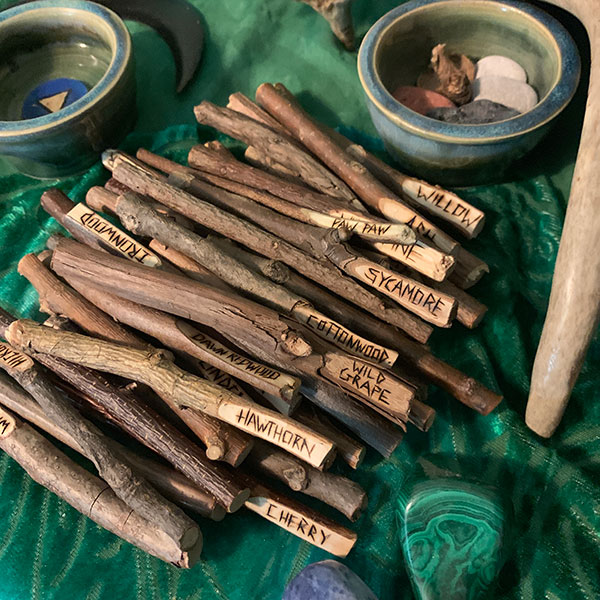
Ever since I self-published the Tarot of Trees, I get a fairly regular stream of people who are interested in creating their own oracle decks and want to know how to do it. So in today’s post, I’ll share the process of developing a variety of different oracles. Some were published oracles, like The Tarot of Trees and my forthcoming Plant Spirit Oracle, while others were private oracles just for me, such as the Ancestor Oracle and my ongoing East Coast Ogham project and tree spirit project. Through these projects, I detail the process for how you might create your own. We’ll talk about the act of creation itself, as well as options for if you want to get it out into the world (self publish, print on demand, etc).
In today’s post, I’m going to focus on oracle decks that you make just for you–without the intention of mass-producing them. I’ll share various options for your deck and my own experiences in making many such decks. In next week’s post, I’ll share details about how to make an oracle with the intention of getting it published or self-publishing). I’m splitting up these posts for a very good reason. If you are making your own deck that is only for you, you don’t have to worry about a lot of considerations that go into printing and mass production (funding a print run, marketing, standard printer die-cut sizes for cards, etc). If you are making one just for you, you can do whatever you want, however, you want it. If, however, you want to publish your work (either through a publisher or through self-publishing means) then you have to pay attention to certain considerations–which I’ll cover at some point in the next month or two!
What is an oracle? Why create one yourself?
An oracle is a set of cards, stones, or other objects that allow you to ask questions from spirit. Typically, oracles have a theme (e.g. plants, angels, divinity) and through various imagery or objects they can offer you messages. Many oracles work on the principle of the archetype–which is simply a recurring symbol or theme that is common to the human experience. The maiden, mother, and crone are three such archetypes, as are the fool and the magician from the tarot. When you are creating your own oracle, you can choose what kinds of symbolism and energy you might want to connect with.
There’s a lot of differing opinions about what you are connecting to with when you connect with an oracle deck. Again, I think this depends on the person. Some folks may find that they want it to remain a mystery. Others believe they are connecting with their higher self or subconscious. Others believe that they are connecting with some form of the divine or greater spirit, god/goddess, or universal energy. For some people, these questions matter deeply and for others, they really don’t care where the messages come from as long as they are helpful. While it doesn’t matter what you believe to create your oracle, it can be a useful exercise to consider what the source(s) of the energy is that you are drawing upon.

Self-created oracles have a certain kind of power that you can’t get from an oracle someone else created. A self-created oracle is yours, and only yours. You choose what goes into it. You create it yourself. You choose your symbols and meanings. You are the only one involved in visioning for it, choosing the archetypes or meanings, choosing the media, choosing how it is used. Tremendous power exists in self-determination. You will learn a lot about yourself and what you value through the process of creating your own oracle. At the same time, recognize that it can be a considerable undertaking, sometimes over a period of time (particularly if you are searching out objects for your oracle). It may also be limited by your artistic skill, but there are ways around not being able to draw (e.g. fancy lettering, collage, etc). But it is certainly something worth doing as a “next step” for divination work.
Setting Vision and Intentions
For creating your own oracle deck, I have found it helpful to start by meditating and exploring your own intentions. Each person is unique, and an oracle we create is likewise unique, that should in some way reflect upon who we are as people and what our needs for divination are. Some of the questions you might ask to help you set your intentions are:
- Why do I want to create my own oracle?
- What kinds of questions do I want to ask?
- What questions do I ask of my current oracles regularly?
- What do I like about the oracles/tarot decks that I already have worked with?
- What don’t I like (or is missing) from the oracles/tarot decks that I already have?
- Do I have themes or media that I’m particularly drawn to?
- Do I want to be able to add to my oracle over time?
- How big do I want my oracle to be? (e.g. simple yes/no/maybe questions or deep understandings? The more cards/objects, the more complex of questions and answers you can ask).
Once you have some sense of these questions, it is likely a good time to start making your own oracle. If you don’t have a sense of these questions, you might want to meditate on them for a time and return to the oracle project at a later point. Oracle ideas have a way of sneaking up on you–you may one day be struck with the awen (inspiration) and be ready to go after months of not being sure what to do. That’s ok–these things are rooted in spirit and they work on their own time and in their own way.
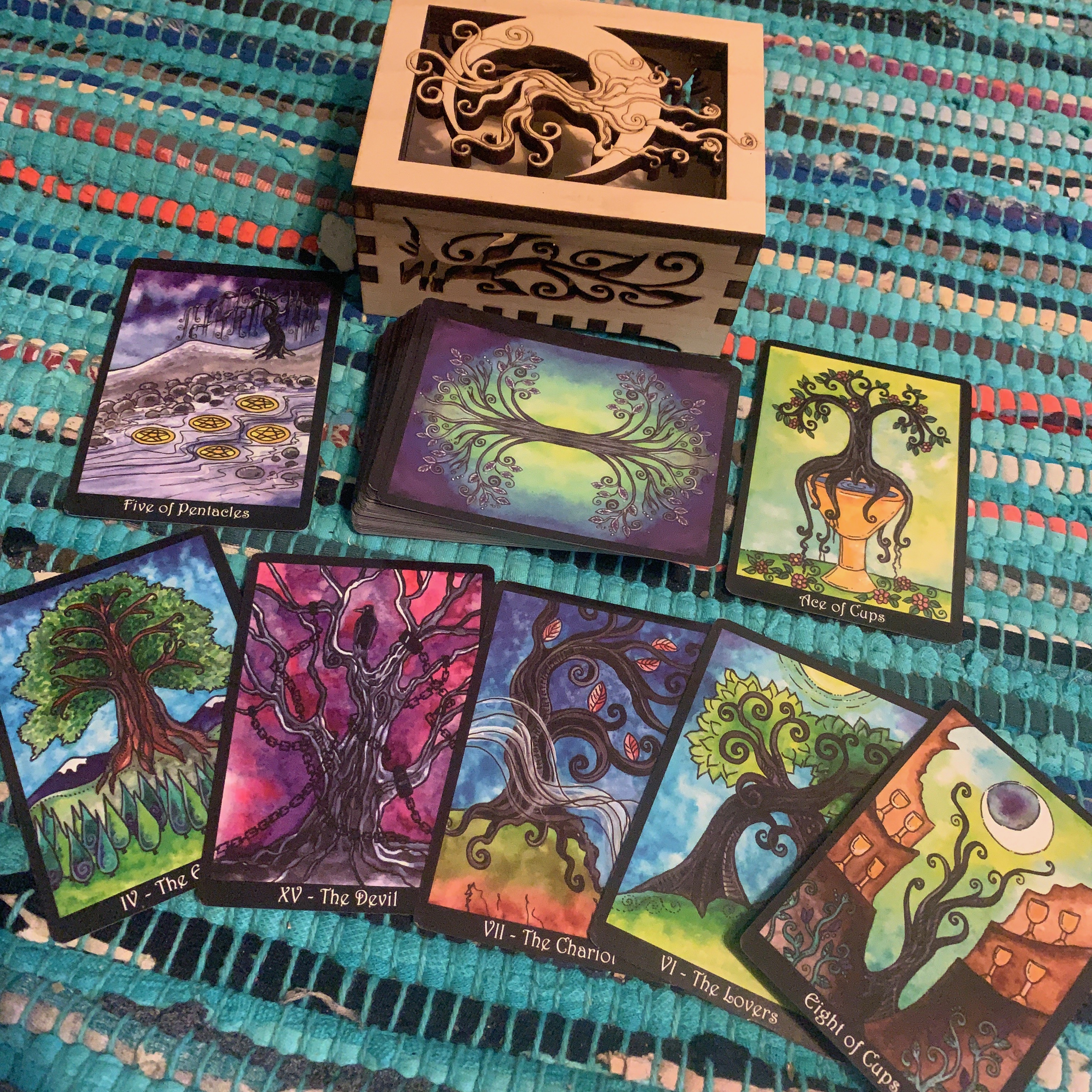
Your Oracle: Established Meanings or New Ground
Planning is your first step, and a multitude of options exist for you designing your own oracle. First, you have to decide if you are going to use an established set of meanings (runes, ogham, or Tarot) for your basis for creating an oracle or if you are going to create something entirely new and unique. This is an important choice. Here are your two options:
Using and adapting an established oracle/tarot system.
Choosing to use something that is already established (runes, tarot, ogham, etc) gives you a basic blueprint of how to proceed. Your major work using this approach is interpretation and manifestation. Your planning, then, has a lot to do with how you interpret the existing body of meanings to your specific theme and plan. If you are going to start with a set of established meanings–then those meanings will be a guide as you plan your deck. In this case, the plan is already before you (e.g. 78 cards, 4 suits + major arcana in the case of the tarot, 22 ogham staves in the case of the ogham, etc). Your job is simply to interpret those archetypes how you see fit.
The Tarot of Trees took this approach–I made a tarot deck. I changed some of the meanings and adapted the suits to fit a seasonal and elemental approach, but ultimately, the suits and cards are familiar to anyone who works with other Tarot decks. There’s still a lot of room for flexibility and creativity in this approach but it does give you some structure, which is helpful to many people. In the case of the Tarot of Trees, I focused on one tarot card at a time, starting with the majors. I meditated on each of the traditional meanings and then envisioned what that might be when translated to a tree focus. I read different interpretations of the cards. Thus, while some of my cards were fairly classical (the 3 of swords) others, like the Wheel of the Year (Wheel of the Seasons in the Tarot of Trees) or the Heirophant, went off in interesting directions.
Creating an entirely new oracle system.
The alternative is to go off in a completely new direction and create an entirely new oracle that is specific to you and that does not use an existing framework. This allows you to create something entirely unique, with your own symbology and meanings. Deeply personal oracles that are self-created have real power because they speak directly to you and are created by you. I highly recommend you do so at some point on your spiritual journey! In this case, your work is very different. Not only are you creating the oracle itself, but also the entire framework and system for meaning. Let me give you two examples, which will help illustrate this process.
The Ancestor Oracle Deck is one such example that I’ve created (not the only one I’ve made, but the only I’ve shared publicaly on this blog prior to this post). In this case, I wanted to create an oracle deck that evolved as my own life did–I wanted to create an ancestor deck that I could connect with and use at Samhain, and I wanted to be able to add ancestors to my deck as loved ones passed on as part of my own mourning process. Obviously, since this deck was so personal, I would never publish it or share it with anyone else (and I’m even careful about which cards I photograph). This deck had a very specific and meaningful purpose for me–a tool to use for divination, but also for my altar, and my mourning work as I lose someone important. In the case of creating this deck, I did some pre-planning. In the weeks leading up to Samhain, I opened up a sacred grove and invited my ancestors in. I reflected on each of them, and began to keep a running list of three things: who they were, what they meant to me, and what core symbolism I might use to represent them. In the weeks following that, I created the deck itself and made the imagery (see link above for that process). I made a lot of extra cards for that deck, as I know that my collection of ancestors will grow as my dear ones pass. After I made the initial deck, I also spent some time with Ancestry.com, doing my DNA test, and learning much more about my distant ancestors. At this Samhain, I’m going to be adding some of those more distant ancestors that I’ve been connecting to–my oldest tracable ancestors, for example, and some of the core family clans. The deck itself has also helped
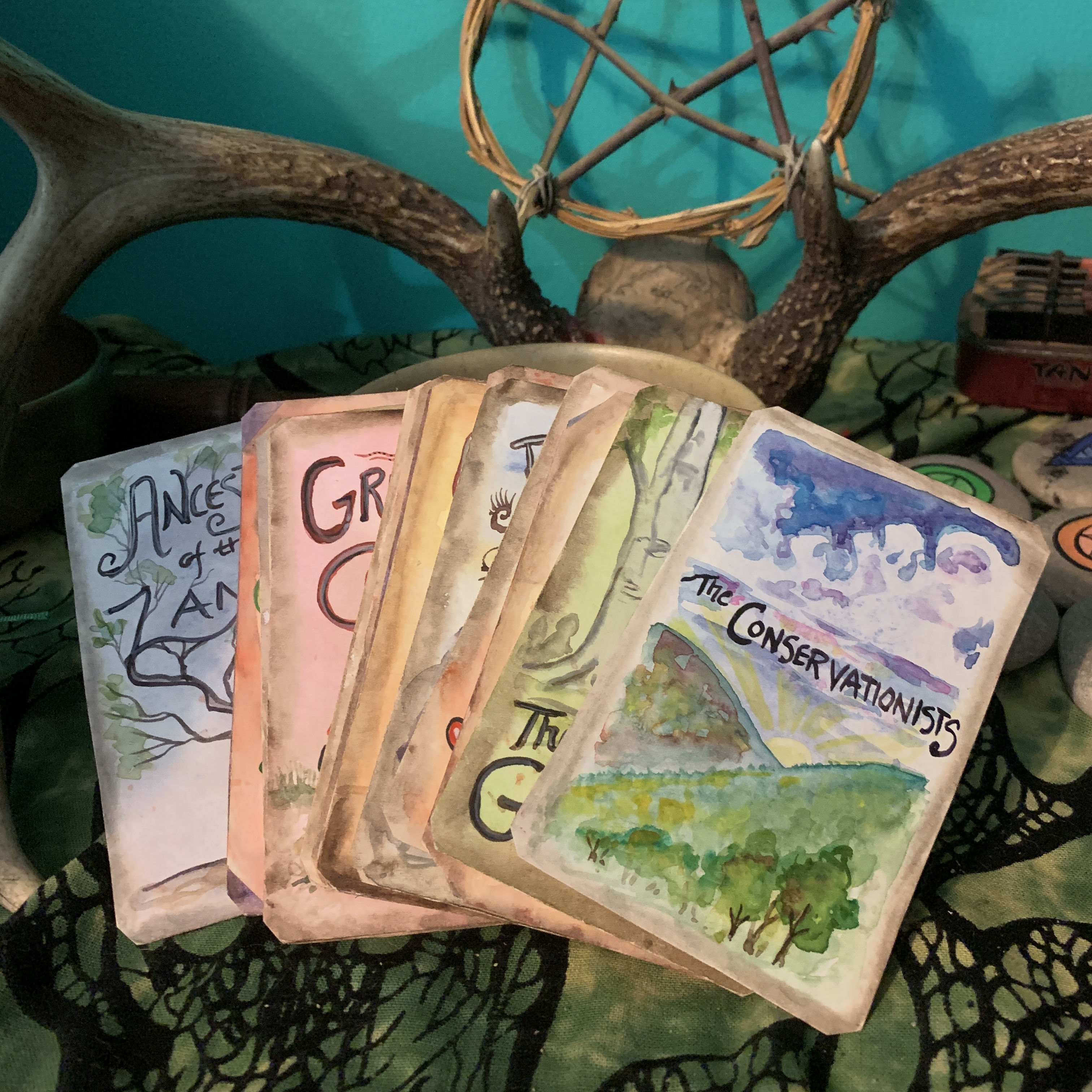
I used a very different approach to create the Plant Spirit Oracle (PSO). Unlike the Ancestor Oracle, which I planned out in advance, the PSO was extremely inductive. I didn’t even know I was creating an oracle till I was about 7 or 8 paintings into the process! I was doing some serious journey work with the Celtic Golden Dawn system. As part of that system, you work with elemental groves and journey between those groves. Each journey introduces you to a guide. When I started the process, I met a plant–black cohosh–and she showed me a painting as part of my journey. I painted it. I kept doing these pathworkings every few weeks. I’d meet plant spirits, and gain an image of what to paint, and use the painting process itself as a meditative tool. Sometimes I would have to journey further to get the meanings or have the meanings revealed to me through meditation, even after already getting the image of what I wanted to paint. For this oracle, I did not plan it in advance, but once I got later in the process and had most of it complete, I did figure out an overall organization for the deck that worked with what I had and created a few cards tht “filled in” the gaps of the meanings I needed, I would say, it was almost an intuitive and spirit-led approach.
And so, some general principles we can take away from these two examples:
Like most things, multiple options exist for how to proceed for designing your own oracle. One is the intuitive or inductive approach, where you simply work with one card or object at a time and use intuition/spirit to get you where you are going (my example of the Plant Spirit Oracle). The other approach is and one is the plan-ahead or deductive approach (which is what I did with the Ancestor Oracle). Both approaches have their benefits and drawbacks, and they really will depend on who you are, the vision you have, and how you are most comfortable proceeding. You might also find that a bit of both is the best approach–planning what you know you want to include, and leaving the rest up to divine inspiration as you create.
If you are coming into this process with a fairly strong vision for your oracle, it might pay to plan it in advance. That is, it might pay you to sit down and map out what the meanings are that you want to create, the kinds of things you need in your oracle, what you want it to look like, and maybe even ideas on how you’ll read it and use it. A map (visual) or outline can be helpful as you plan, think through, and revise before beginning.
If you are not coming in with a strong vision, then I suggest you simply look to the world around you for inspiration and use your core spiritual practices to get you there. As you are in the act of creating, you may come across experiences or things in nature that resonate–write them down, collect them and help build them into your oracle. Or you can create or adapt a specific set of practices just for oracle creation.
Whew! There’s a lot to think about when it comes to which path you want to take to creat your oracle. Now, we move into the next phase of creation. You will need to make decisions about what (matter) and what the meanings will be (spirit).
Matter: Options for Making Your Oracle
You can make your oracle literally out of anything–collage or found images, photography, hand-paintings, small objects like bones, wood burned slices of wood, stones, acorn shells and much more more. Even if you have you have not honed your drawing or painting skills, there are still lots of other options for you. I’ll cover some of those options here and offer you some ideas to get you started.
Paper-based options
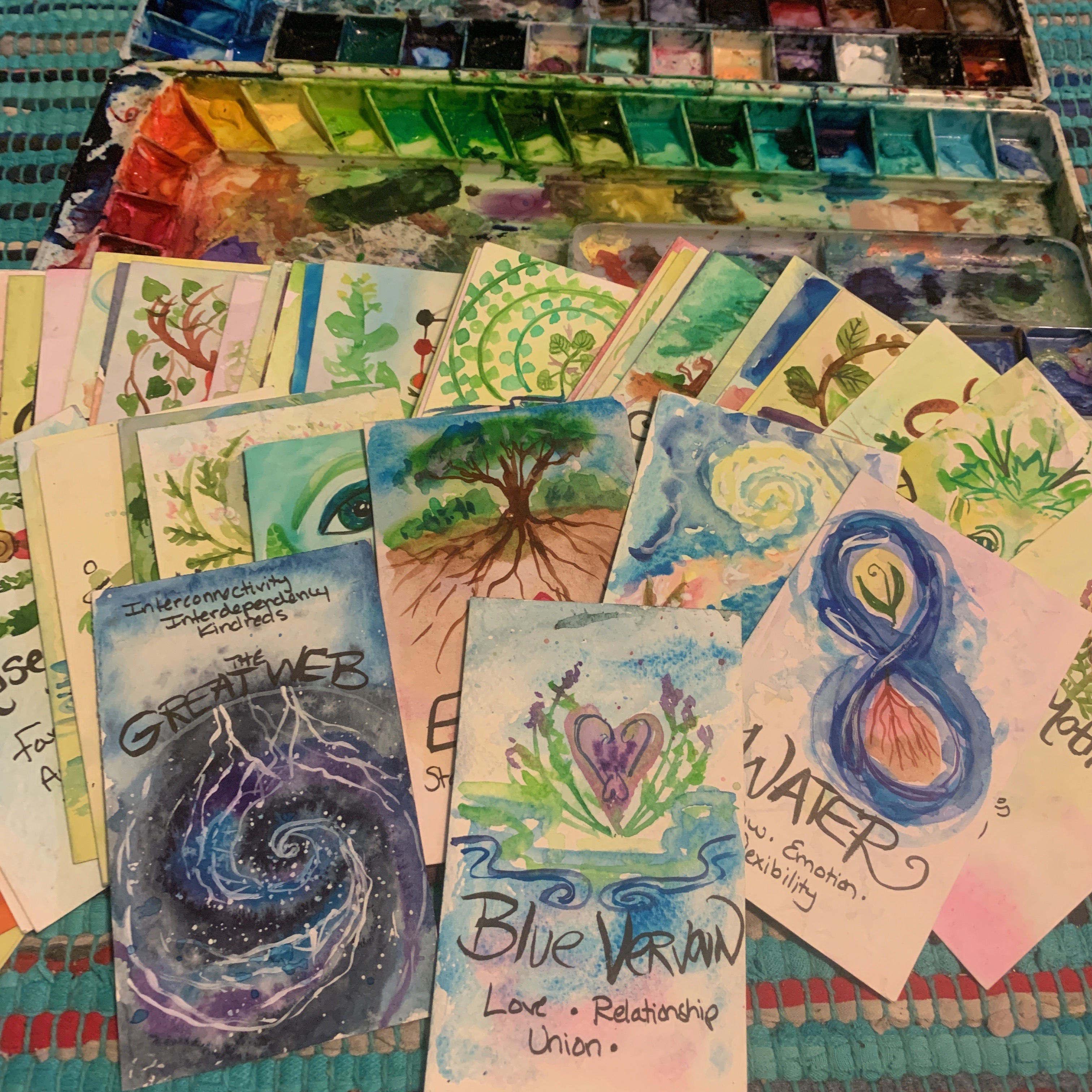
Paper-based options are good for oracles–a heavy paper (like watercolor or bristol) stands up well to repeated use, and paper-based oracles can travel easily. Here, play around with some potential ideas till you find something you really like and start to make the cards. cards can be any size or shape (and feel free to get creative here–round oracle cards are a thing). Make a few mock-up cards and see how the awen is flowing. If you are thinking of going this route, here are some options for you.
- Pre-cut cards. If you look online, you can easily find different sizes of pre-cut cards that are ready to go. These include various kinds of colors, thicknesses, etc. Using these as a starting point is a great way to go–get some stamps or markers, or your printer, and away you go!
- Watercolor backgrounds and Lettering: An oracle can be made just of watercolor backgrounds and lettering (see the watercolor background technique in the Ancestor Oracle post). Anyone can make these backgrounds, and if you put them on a good watercolor paper, you can end up with a really nice place to start for images or lettering.
- Lettering is an art form in and of itself and does not require the same level of skill as drawing. I would suggest checking out this list for books that can inspire you.
- You could use a handmade paper technique where you use recycled papers or natural materials. Again, handmade paper techniques are easy to learn and require no drawing ability. Then put some nice lettering on your cards and away you go!
- Handpainted cards: Create fully handpainted cards. Paint them at the size, or patin them larger. I did both for the Plant Spirit Oracle: I made a “mockup” deck work out the meanings and uses for the Plant Spirit Oracle. I also had larger 11×14″ paintings for each. For the Ancestor Oracle, I made only one card, and that was handpainted.
- Collage techniques. Gather up some inspirational magazines, glue, and some heavy cardstock and go to town! You can create wonderful, intuitive collages (similar to a vision boarding technique). You can do these very intuitively–light some candles, put on some quiet music, and put yourself in a good place. Then, go through the magazines and material and pull things out that speak to you. Cut them, and assemble them into cards with words and pictures. An oracle is born!
- You can do digital art and then do a one-shot print run (such as through makeplayingcards.com). Or you can print them out locally or on your home printer. I did this for my Tree Spirit Oracle (which may or may not become a deck I release).
- You can carve vegetables or various kinds of blocks (wood, linoleum) and create a printed deck (I’ve always wanted to do this, but haven’t gotten to it yet. But I did make a set of cool elemental garden flags some time ago!)
- You can also do basic stamp techniques with natural materials like leaves, etc.
- There are papers you can get that turn colors when exposed to the sun. Use these with natural materials to create amazing and accurate prints. Look for “sun print paper” or “sun-sensitive paper”.
- Doodles/pen and ink. Zentangle techniques are meditative and fun and again, something anyone can do. These done intuitively with words or images would make a really cool oracle!
These are just some of many, many paper-based media options. Play around and see what speaks to you. Browse places like Deviant Art or Instagram to get ideas of what is possible and what may speak to you.
Object and Wooden options
Because of the prevalence of oracle decks, sometimes we forget that other materials also make great oracles. Thus, your oracle does not have to be paper-based but rather can be made of objects of all kinds. Objects give you a different kind of interaction, a much more tactile interaction, and can be a lot of fun to put together.
- Found natural objects: sticks, stones, shells, and feathers can make a great oracle deck. Put different gathered objects together in a bag, assign meanings, and you are ready to roll.
- Stones: Collect or purchase different colored stones. Paint them (or not) and assign meanings. You might also want to tumble them or leave them as is.
- Bones. In the hoodoo tradition, throwing the bones is a very common divination practice. I have a friend who has a wonderful bone set–she collected them all herself, over time, and she also created a great casting cloth (see below) for her bone set.
- Wood and sticks: You can do a lot with different kinds of wood, either slices of wood cut with a miter saw or sticks cut just with little hand tools. You can slice off one end of a stick and give meaning or symbol. Wood rounds make excellent sets for runes and other things. Woodburning these works best (see a photo of my ongoing East Coast Woodlands Ogham project for a simple example).
- Clay: You can do natural pottery (fired in a hot bonfire), air dry clay, or polymer clays like Sculpey or fimo. You can shape things with them, or roll them out, use a little circle to cut out shapes, and then press other things into them (like stamps, old buttons, etc). I would recommend you think about the portability of clay objects–how heavy will they be together?
Spirit: Developing Meanings and Uses
The spirit of the oracle refers to what it means and how you use it. Meanings and how you gain those meanings are obviously central to any oracle deck. Developing an oracle, even if you plan it in advance, requires working with it to finalize the meanings and develop your understanding and relationship with that oracle.
Developing meanings
I began talking about how to develop the meanings above, and I will continue that discussion here. The first way of developing meanings is through lots and lots of research. My East Coast Ogham project, for example, is mostly a research-heavy project where I explore the different history, folklore, herbalism, physical uses, and mythology surrounding trees here in the eastern part of the USA and then derive my own meanings for it. That project has been a labor of love, and when you see a sacred tree post from me, that’s part of that project. (Thus far, I’ve covered Cherry, Juniper, Birch, Elder, Walnut, Eastern White Cedar, Hemlock, Sugar Maple, Hawthorn, Hickory, Beech, Ash, White Pine, and Oak as part of that project!). I’ve made many more tree stick oghams that aren’t yet researched. Each of these trees requires many hours to research, but the process is so rewarding. In the end, this oracle will probably take me the longest of any I’ve created–but it will be all hand-gathered and from the heart.
The second way of developing meanings is through spiritual work such as meditation, nature observation, and sprit journeying. That’s how I developed the Plant Spirit Oracle. I did extensive journeying over a 4 year period and through those journeys, received not only the design of each card but their overall meanings. I already shared that process above a bit.
Another way of developing meanings is by meaningful personal association. This was how I developed the Ancestor Oracle. I had ancestors, I wanted to think about their role in my life and what messages they might have. Sometimes, I had done spirit journeying work with them, and other times, it was simply what I remembered of them, stories I had been told, or what they meant to me personally. For example, in the Ancestor Oracle, I have a card for “The Conservationists.” I honor those who worked to create the beautiful state and national parks that I so enjoy as a druid. This included many of the members of the CCC, the Civilian Conservation Corps, who built cabins, created paths, and really built our national and state park system here in PA from the ground up. I created that card several years ago and each Samhain, I honor those as one kind of ancestor of this land. I was only a few weeks ago I was camping with my family, and we were staying at Parker Dam State Park staying for the weekend in one of those CCC-built cabins. My mother mentioned to me that my great-great-uncle had been a member of the CCC. How delighted I was to find this out! Now the card takes on additional meaning, as now it also represents at least one ancestor of my blood. These are the kinds of personal and meaningful associations that can develop over time, even after you finish your oracle.

The final way is if you are working with an existing framework (tarot, ogham, runes, etc) and making it your own. This is what I did with the Tarot of Trees. To do this, I first started by working with other tarot decks and books and just learning how the Tarot worked. I took my own notes and as I used these decks, I intuited my own interpretations over time. I painted the first card of the Tarot of Trees–the Tower–to better understand this card through meditation (I do a lot of meditation through my bardic arts). Then I just kept going. The general idea here is that you need to understand the system you are working with enough to interpret it and adapt it in whatever way you choose. You can also add cards or subtract cards–this is your work. For example, in the Tarot of Trees in the 3rd edition, I added a 79th card to the deck, “regeneration.” This card, for me, was about hope and life. I did this after studying permaculture design and feeling empowered about the potential role that humans could play in regenerating the earth.
Regardless of how you create your meanings, the final thing to remember here is that meanings and oracles evolve. Even with original meanings, you have to work with the oracle to figure out the fine details of the meanings, the ways that different cards might interact, and the ways that you interact with your creation. Allow for flexibility and time for these meanings to develop and understand that this is a process. Keep a journal of what you understand the meanings to be, and allow yourself to
Developing Ways of Use
So you have an oracle and you have some basic meanings. Congratulations! The final thing you need to consider is how you can ask questions: that is, how do you draw objects or cards when you ask questions? How might you arrange them in a logical fashion? You have lots of options here as well.

- For cards and objects, you might consider different kinds of spreads. You can invent your own spreads for use with your divination system or you can use previously created spreads that you like. For example, a commonly used spread in the Tarot community is the Celtic Cross spread. Experiment with your oracle, see what kinds of placement and meanings speak to you. I suggest you start simple and then work your way to more elaborated spreads and readings.
- You can also use different kinds of casting techniques. These are particularly useful for objects like runes, bones, stones, etc. Perhaps you craw one after another out of a bag. Perhaps you cast the entire of your oracle on a casting cloth, where different positions and directions on the cloth mean different things. Perhaps you draw 4 then drop them on a table, seeing which directions they point and how they interact. If you google “Casting cloth” you will see a lot of possibilities for existing casting cloths that can help you be inspired to create your own.
- Consider interaction: how do different cards interact with other cards? how might they
Use your Oracle
Oracles are meant to be used, either by you or perhaps by you reading for others. The process of creation continues as you use your oracle, develop deeper meanings and relationships between the different cards/objects, and develop a deep connection between it and yourself. I’d like to conclude by suggesting that you allow yourself flexibility in adding and adapting your oracle even after you consider it “done” as you never know what new meanings or messages spirit will have for you.


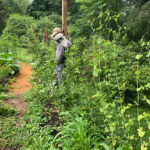
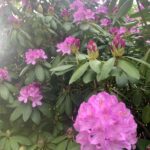
Reblogged this on Paths I Walk.
Hey,how do you also create the back of the card on the program and then print it? This is if I decide to do it digitally and self-print it at home. What program can I use?
You can paint the back of the card like any other. Then you can scan and import it. If you are using a printer or even a place like MakePlayingCards.com, they will ask you to upload the back cover file separately. I haven’t done printing at home but I’m sure you can.
I use Adobe Photoshop and Adobe Indesign. Those are expensive programs though, and there are free programs available to you, like Gimp. Best of luck! 🙂
Your cards are so beautiful! <3
Thank you! 🙂
Very inspirational post, dear Dana! And my congratulations to your amazing Tarots!
Thank you! And thank you for reading! 🙂
You are welcome, dear Dana. And thank you for posting these essential vital posts. I enjoy your blog regularly.
The very idea of an Ancestor Oracle is simply a stroke of genius. It’s all the more relevant as Samhain approaches, and for me, as I approach my 50th year, I have more ancestors than ever before, with more inevitable, as beloveds begin to fade and pass away. It’s an intriguing idea that immediately started to percolate. 🙂 Thanks for sharing what cards you did share and showing that it need not be limited to individuals, but can include collectives or unknown ancestors, such as The Grandmothers. Thank you!
Reblogged this on Good Witches Homestead.
Reblogged this on Rattiesforeverworldpresscom and commented:
It sounds wonderful!
Your cards are so beautiful and inspiring . Thanks so much for all your information and teaching on making my own tarot. I come across your blog when I was searching how to make my own oracle. thanks for your great sharing.very appreciated. ^^
Thank you, TY! Thank you for reading and coming to visit the Druid’s Garden!
Such an inspiring and helpful post! Thank you so much. I’m in the throes of exploring making my own animal oracle deck that I’d like to eventually self-publish. In your article you mentioned your next post would be on self-publishing or publishing an oracle deck, but I don’t seem to be able to find it. Can you provide a link here? Also, I’m interested in your plant oracle deck, but can’t seem to find where to purchase that. Thanks much!
I haven’t written that post yet–but I can soon :).
You can purchase the Plant Spirit Oracle deck here:
https://www.etsy.com/shop/Phyteasana
That will be wonderful. I’ll look forward to reading it.
Thanks. Had this flowing around in my head since some time – and how much more meaningfull a deck done by myself would be. And you just showed me the way. Reading though your post, ideas and cards popped into my head, a mix of my ancestors, of my beloved gone friends and animals, and those who still help and protect me, and the dreams I keep making of them, full of symbols and meanings that I can use as cards too. Ill definitively follow your work – you don’t give already made recipes, you show us how to find our own way, which is so much better !
Thank you for this! I’m in the midst of creating my own tarot Deck, the Sparkling Sun tarot deck – so to read your post was really enlightening! Lots of food for thought. It’s a real job to get it all going isn’t it but small steps help. Great to hear from others who have been through the process.
Lila, that sounds like a great deck. Do you have a site or instagram for it?
Yes, the decks are a lot of work but are really enjoyable to make. I like working on such a project!
Have you finished your Spirit Tree Oracle deck. I’m so interested in it.
Hi Cody, I’m working on it now! I’ll post updates on the blog when we are doing the crowdfunding campaign (either late fall or early spring). If you follow me on Instagram, I’m offering some regular updates as I’m working on the final cards and layout in the next few months :). Thanks so much for your interest and support! 🙂
Thank you so much for the help! Very gracefull!
You are most welcome! 🙂